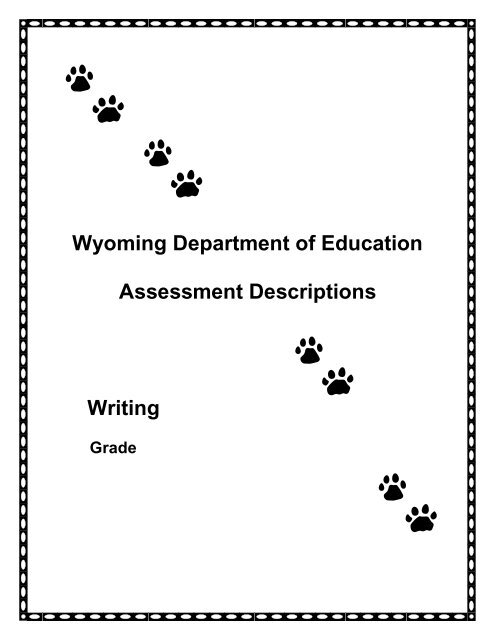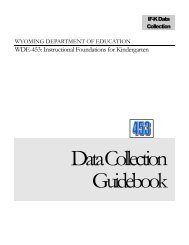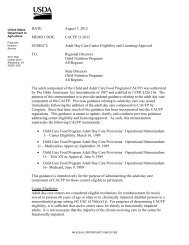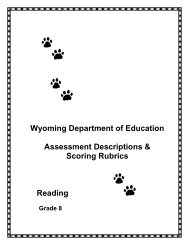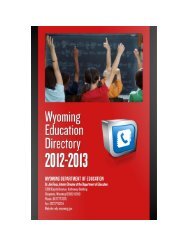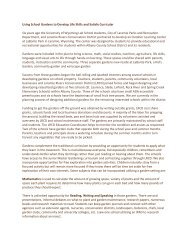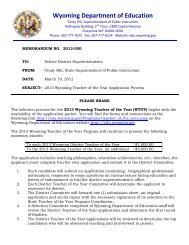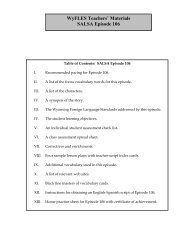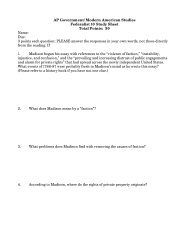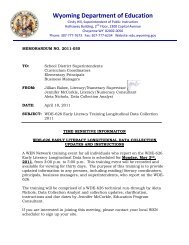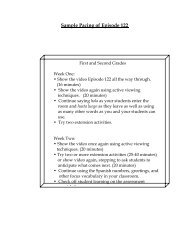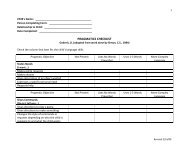Writing Assessment Descriptions-Writing Scoring Guide Grade 6
Writing Assessment Descriptions-Writing Scoring Guide Grade 6
Writing Assessment Descriptions-Writing Scoring Guide Grade 6
You also want an ePaper? Increase the reach of your titles
YUMPU automatically turns print PDFs into web optimized ePapers that Google loves.
Wyoming Department of Education<br />
<strong>Assessment</strong> <strong>Descriptions</strong><br />
<strong>Writing</strong><br />
<strong>Grade</strong>
TABLE OF CONTENTS<br />
I. The Instructional Focus of Wyoming’s State <strong>Assessment</strong><br />
System .................................................................................................................... 3<br />
II. Purpose of <strong>Assessment</strong> <strong>Descriptions</strong> ...................................................................... 4<br />
III. Explanation of PAWS Content Area Skills ............................................................... 4<br />
IV. PAWS <strong>Writing</strong> Skills ................................................................................................ 4<br />
V. A Framework for Assessing the <strong>Writing</strong> Skills ......................................................... 5<br />
VI. Evaluative Criteria for the <strong>Writing</strong> Skills ................................................................... 5<br />
VII. Two <strong>Writing</strong> Contexts .............................................................................................. 6<br />
VIII. Explanation of Coding ............................................................................................. 7<br />
IX. <strong>Assessment</strong> <strong>Descriptions</strong> and <strong>Scoring</strong> <strong>Guide</strong>s ........................................................ 7<br />
<strong>Grade</strong> <strong>Writing</strong> <strong>Assessment</strong> <strong>Descriptions</strong> / <strong>Scoring</strong> <strong>Guide</strong>s ....................... 8 - 13<br />
________________________________________________________________________________________<br />
Wyoming Department of Education July 2010 Page 2 of 13 Pages
I. The Instructional Focus of Wyoming’s State <strong>Assessment</strong><br />
System<br />
Wyoming believes it is possible to build statewide assessments that comply with the<br />
requirements of the No Child Left Behind Act of 2001 (P.L. 107-110) while still<br />
providing teachers information that is critical to improving instruction for individual<br />
students. To this end, Wyoming has embraced the requirements outlined in the<br />
October 2001 report written by The Commission on Instructionally Supportive<br />
<strong>Assessment</strong> and has constructed its statewide assessment system using the guidance<br />
provided by the report.<br />
Instructionally supportive assessments are assessments intended to promote<br />
more effective classroom instruction.<br />
Teachers will receive PAWS (Proficiency <strong>Assessment</strong> for Wyoming Students) results<br />
by skill for each of their students in each content area tested. Final scores for the<br />
PAWS writing assessment will be reported by context, or mode (Expository and<br />
Expressive), and by skill (Idea Development, Organization, Voice, and Conventions).<br />
These results are intended to help educators make informed decisions about<br />
curriculum and instruction. Since PAWS is aligned to academic content and student<br />
performance standards, student results can reveal strengths and weaknesses in<br />
curricula or instructional methodology. Thus, it can also help educators target specific<br />
areas necessary for school and district improvement. The use of assessment results<br />
to support informed decision-making for improved teaching and learning in Wyoming<br />
schools is an expectation of the PAWS design approach.<br />
PAWS Testing Overview<br />
All Wyoming public school students in grades three through eight and grade eleven<br />
will test in reading, writing and mathematics, and students in grades four, eight and<br />
eleven will test in science during the testing window. Adequate yearly progress (AYP)<br />
determinations will be made using the data received from the reading, writing and<br />
mathematics assessment results.<br />
<strong>Grade</strong> 10: Students in grade ten are allowed to take advantage of an early testing<br />
opportunity. Students may “bank” their mathematics and/or reading and writing scores<br />
during their tenth grade year. AYP will be determined only for students in grade<br />
eleven using their “banked” scores or scores achieved during the official testing<br />
window, whichever is higher. In order to bank a language arts score, students must<br />
complete the reading and writing tests during the same testing window.<br />
________________________________________________________________________________________<br />
Wyoming Department of Education July 2010 Page 3 of 13 Pages
II. Purpose of <strong>Assessment</strong> <strong>Descriptions</strong><br />
In the past, teachers have been faced with the perplexing task of trying to prepare<br />
their students to take the state test without knowing which standards/skills will or will<br />
not be assessed on a given form of the test. To ensure that PAWS is instructionally<br />
supportive, assessment descriptions have been developed to clearly and thoroughly<br />
describe the knowledge and skills for each assessed content area that will be tested<br />
and the evaluative criteria to be used to assess each skill.<br />
III. Explanation of PAWS Content Area Skills<br />
The Wyoming Content and Performance Standards serve as the foundation for a set<br />
of comprehensive, measurable PAWS content area skills. The PAWS skills were<br />
created through the analysis and categorization of highly related Wyoming Content<br />
Standards and Benchmarks. These standards and benchmarks, when used<br />
successfully to guide instruction, build students’ understanding of the major concepts<br />
and principles within each content area. These major concepts and principles<br />
comprise the substance of the PAWS content area skills. The PAWS skills described<br />
for educators in the Wyoming <strong>Assessment</strong> <strong>Descriptions</strong> meet the following set of<br />
criteria:<br />
• The skills are organized into major concepts and principles that encompass<br />
highly related Wyoming content standards and benchmarks.<br />
• The skills support a variety of instructional strategies administered by Wyoming<br />
teachers.<br />
• The skills can be defined as somewhere between the breadth of a content<br />
standard and the specificity of a benchmark.<br />
Through the use and measurement of the PAWS content area skills, PAWS<br />
successfully fulfills two major purposes. First, it provides information about student<br />
attainment of the knowledge and skills within the Wyoming Content and Performance<br />
Standards in reading, writing, mathematics, and science over time. Second, and<br />
equally important, it provides additional skill-level reporting categories aligned to the<br />
Wyoming Content and Performance Standards as organized by the Wyoming<br />
<strong>Assessment</strong> <strong>Descriptions</strong> to assist teachers in interpreting and addressing specific<br />
academic needs of students.<br />
IV. PAWS <strong>Writing</strong> Skills<br />
The PAWS writing tasks will assess students in four skill areas: Idea Development,<br />
Organization, Voice, and Conventions. Students will be asked to demonstrate their<br />
abilities to respond to a topic while considering both purpose and audience. The<br />
following provides a brief explanation of the performance expectations for each skill:<br />
________________________________________________________________________________________<br />
Wyoming Department of Education July 2010 Page 4 of 13 Pages
Idea Development<br />
The writer develops the content of the message through the use of details.<br />
Organization<br />
The writer builds the organizational structure to support the purpose and<br />
effectiveness of the writing.<br />
Voice<br />
The writer uses effective language to communicate to the audience in a way<br />
that is individual, compelling, and engaging.<br />
Conventions<br />
The writer develops the mechanical correctness of the piece including spelling,<br />
capitalization, punctuation, and grammar.<br />
V. A Framework for Assessing the <strong>Writing</strong> Skills<br />
The Wyoming Language Arts Content and Performance Standards set the expectation<br />
that students will use the writing process (generate ideas, draft, revise, and edit) to<br />
demonstrate their writing abilities in four skill areas (Idea Development, Organization,<br />
Voice, and Conventions) within various contexts, or modes, of writing. To achieve this<br />
end, the PAWS writing assessment provides a drafting session and an edit/final copy<br />
session to allow students to utilize the writing process.<br />
VI. Evaluative Criteria for the <strong>Writing</strong> Skills<br />
“Evaluative Criteria” are the factors used to determine the performance of students’<br />
writing skills. The evaluative criteria for Idea Development, Organization, Voice, and<br />
Conventions are identified within the PAWS <strong>Writing</strong> <strong>Assessment</strong> <strong>Descriptions</strong> and the<br />
PAWS Expressive and Expository <strong>Writing</strong> <strong>Scoring</strong> <strong>Guide</strong>s. Students receive scores of<br />
0, 1, 2, or 3 in each of the skill areas based on their level of performance. The PAWS<br />
<strong>Assessment</strong> <strong>Descriptions</strong> and <strong>Writing</strong> <strong>Scoring</strong> <strong>Guide</strong>s are important tools for teachers<br />
and students to promote skill mastery. If teachers and students are able to use these<br />
tools to better understand a particular skill’s evaluative criteria, they can become<br />
increasingly adept at monitoring individual progress.<br />
________________________________________________________________________________________<br />
Wyoming Department of Education July 2010 Page 5 of 13 Pages
VII. Two <strong>Writing</strong> Contexts<br />
Students taking the PAWS writing test will respond to prompts covering two contexts,<br />
expressive and expository; each context/mode includes a variety of purpose-specific<br />
writing tasks.<br />
A. Expressive <strong>Writing</strong> Context<br />
Expressive writing shares personal feelings, attitudes, ideas, beliefs and values.<br />
Such writing usually flows from a personal point of view wherein the author<br />
narrates an event drawn from a life experience or tells stories through fictional<br />
characters.<br />
B. Expository <strong>Writing</strong> Context<br />
Expository writing presents problems and develops solutions, describes directions<br />
or procedures for a specific task, and expresses a persuasive argument. Such<br />
writing is typically written to inform a specific or implied audience.<br />
The two writing contexts and the associated writing tasks are listed in Table 1, by<br />
grade level. For more detailed descriptions of each writing context and task, refer to<br />
the PAWS <strong>Assessment</strong> <strong>Descriptions</strong> beginning on page 8.<br />
Table 1<br />
<strong>Writing</strong> Contexts and Tasks<br />
Context (a):<br />
Expressive<br />
Context (b):<br />
Expository<br />
<strong>Grade</strong> 11 Reflective Narrative Persuasive Essay<br />
<strong>Grade</strong> 8 Fictional Narrative Expository Essay<br />
<strong>Grade</strong> 7 Personal Narrative<br />
<strong>Grade</strong> 6 Fictional Narrative<br />
Problem/Solution<br />
Essay<br />
Directions or<br />
Procedures<br />
<strong>Grade</strong> 5 Personal Narrative Report<br />
<strong>Grade</strong> 4 Personal Narrative Formal Letter<br />
<strong>Grade</strong> 3 Personal Narrative<br />
Letter Written to a<br />
Topic<br />
________________________________________________________________________________________<br />
Wyoming Department of Education July 2010 Page 6 of 13 Pages
VIII. Explanation of Coding<br />
The assessment descriptions use a standard code for ease of reference. Codes are<br />
provided at the skill level. The sequence is: Standard/<strong>Grade</strong>/Context/Skill<br />
Key to Skill Codes:<br />
In writing, the skill codes “ID” refers to Idea Development, “O” refers to Organization,<br />
“V” refers to Voice, and “C” refers to Conventions.<br />
W.11.a.ID <strong>Writing</strong>/<strong>Grade</strong> 11/Expressive/Idea Development<br />
W.08.b.O <strong>Writing</strong>/<strong>Grade</strong> 8/Expository/Organization<br />
IX. <strong>Assessment</strong> <strong>Descriptions</strong> and <strong>Scoring</strong> <strong>Guide</strong>s<br />
Beginning on the next page, the PAWS <strong>Writing</strong> <strong>Assessment</strong> <strong>Descriptions</strong> and <strong>Scoring</strong><br />
<strong>Guide</strong>s are arranged by grade level beginning with grade 11. You will find two<br />
alignment tables and one scoring guide for each context, or mode, of writing. The<br />
alignment tables show the link between the PAWS skills and the Wyoming Content<br />
and Performance Standards, as well as PAWS prompt attributes.<br />
________________________________________________________________________________________<br />
Wyoming Department of Education July 2010 Page 7 of 13 Pages
PAWS <strong>Assessment</strong> <strong>Descriptions</strong> - <strong>Grade</strong> 6 <strong>Writing</strong><br />
Expressive <strong>Writing</strong> – Fictional Narrative<br />
Wyoming <strong>Writing</strong> Content Standard- Students use the writing process and use appropriate strategies to write a variety of<br />
expressive and expository pieces.<br />
Benchmark Sub-Benchmarks Prompt Attributes<br />
6.2B<br />
Students write<br />
a variety of<br />
expressive<br />
and expository<br />
pieces.<br />
6.2A<br />
Students<br />
apply writing<br />
skills to plan,<br />
draft, revise,<br />
and publish<br />
writing for<br />
intended<br />
audiences.<br />
6.2B.2<br />
Students write and share literary texts (personal narratives,<br />
journals, poetry, short stories) using grade-level-appropriate<br />
strategies such as:<br />
1) Establishing appropriate point of view;<br />
2) Including sensory detail and concrete language;<br />
and<br />
3) Using a range of narrative devices including<br />
dialogue and suspense.<br />
6.2A.5<br />
Students use a variety of writing tools including a thesaurus,<br />
dictionary, reference material, and technology.<br />
6.2A.6<br />
Students use strategies to draft and revise written work such<br />
as producing multiple drafts.<br />
6.2A.7<br />
Students use strategies to edit and publish written work.<br />
The prompt is designed to elicit a response<br />
in which the student demonstrates the use<br />
of story elements to convey ideas and<br />
images in a fictional form. The writing<br />
usually flows from a personal point of view<br />
wherein the author narrates an event drawn<br />
from a life experience or tells stories<br />
through fictional characters.<br />
The first sentence of the prompt introduces<br />
the topic of the prompt with a brief definition.<br />
The second sentence is written to prompt<br />
the students to write about the topic.<br />
Released Prompt:<br />
“Most people find animals interesting.<br />
Imagine you could be your favorite animal<br />
for a day. Write a story about what you<br />
would do if you were that animal for a day.”<br />
____________________________________________________________________________________________________________________________________<br />
Wyoming Department of Education July 2010 Page 8 of 13 Pages
PAWS <strong>Assessment</strong> <strong>Descriptions</strong> - <strong>Grade</strong> 6 <strong>Writing</strong><br />
Expressive <strong>Writing</strong> - Skill Expectations<br />
Wyoming <strong>Writing</strong> Content Standard- Students use the writing process and use appropriate strategies to write a variety of<br />
expressive and expository pieces.<br />
Benchmark Sub-Benchmarks PAWS <strong>Writing</strong> Skills/Evaluative Criteria<br />
6.2A<br />
Students apply<br />
writing skills to<br />
plan, draft, revise,<br />
and publish<br />
writing for<br />
intended<br />
audiences.<br />
6.2A.1<br />
Students use a variety of strategies to generate ideas for written work<br />
such as developing a plan, grouping ideas, and organizing information<br />
using a controlling idea and adequate details.<br />
6.2A.2<br />
Students use introduction, body, and conclusion, with supporting<br />
sentences and details to develop ideas in multi-paragraph expository<br />
and persuasive modes.<br />
6.2A.3<br />
Students use persuasive word choice, engaging voice, and correct<br />
sentence structure.<br />
6.2A.4<br />
Students use grade-level-appropriate conventions of capitalization,<br />
spelling, punctuation, grammar and usage such as present perfect,<br />
past perfect, and future perfect verb tenses, indefinite pronouns, verbs<br />
that agree with compound subjects, and semicolons to connect<br />
independent clauses.<br />
Idea Development - The writer develops the content of the<br />
message through the use of details.<br />
• Develops clear ideas in response to the topic<br />
• Demonstrates effective use of story elements to<br />
develop a fictional story<br />
• Uses descriptive details to enrich idea development<br />
Organization - The writer builds the structure to support the<br />
purpose and effectiveness of the writing.<br />
• Develops an effective beginning, middle, and ending<br />
• Uses topic sentences and varied transitions between<br />
paragraphs<br />
• Indicates paragraphs using appropriate spacing or<br />
indentation consistently; effectively organizes similar<br />
ideas<br />
• Uses varied and correct sentences<br />
Voice - The writer uses descriptive, original language to<br />
communicate directly to the audience in a way that is<br />
individual, compelling, and engaging.<br />
• Narrative consistently reveals personal voice or style<br />
appropriate to the purpose<br />
• Uses a variety of descriptive and original words or<br />
phrases<br />
Conventions - The writer develops the mechanical<br />
correctness of the piece including spelling, capitalization,<br />
punctuation, and grammar.<br />
• Uses grade-appropriate spelling consistently<br />
• Uses grade-appropriate capitalization and punctuation<br />
consistently<br />
• Uses grade-appropriate grammar and usage<br />
consistently<br />
____________________________________________________________________________________________________________________________________<br />
Wyoming Department of Education July 2010 Page 9 of 13 Pages
PAWS <strong>Writing</strong> <strong>Scoring</strong> <strong>Guide</strong> - <strong>Grade</strong> 6 Targets<br />
Expressive: Fictional Narrative—Demonstrates use of story elements to develop a fictional<br />
narrative for an audience<br />
SKILLS 3 2 1 0<br />
Idea Development<br />
The writer develops the content<br />
of the message through the use<br />
of details.<br />
Organization<br />
The writer builds the structure to<br />
support the purpose and<br />
effectiveness of the writing.<br />
Voice<br />
The writer uses descriptive,<br />
original language to communicate<br />
directly to the audience in a way<br />
that is individual, compelling, and<br />
engaging.<br />
Conventions<br />
The writer develops the<br />
mechanical correctness of the<br />
piece including spelling,<br />
capitalization, punctuation, and<br />
grammar.<br />
• Develops clear ideas in<br />
response to the topic<br />
• Demonstrates effective use of<br />
story elements to develop a<br />
fictional story<br />
• Uses descriptive details to<br />
enrich idea development<br />
• Develops an effective<br />
beginning, middle, and ending<br />
• Uses topic sentences and<br />
varied transitions between<br />
paragraphs<br />
• Indicates paragraphs using<br />
appropriate spacing or<br />
indentation consistently;<br />
effectively organizes similar<br />
ideas<br />
• Uses varied and correct<br />
sentences<br />
• Narrative consistently reveals<br />
personal voice or style<br />
appropriate to the purpose<br />
• Uses a variety of descriptive<br />
and original words or phrases<br />
• Uses grade-appropriate<br />
spelling consistently<br />
• Uses grade-appropriate<br />
capitalization and punctuation<br />
consistently<br />
• Uses grade-appropriate<br />
grammar and usage<br />
consistently<br />
• Presents clear ideas in<br />
response to the topic<br />
• Demonstrates use of story<br />
elements to develop a fictional<br />
story<br />
• Uses relevant details<br />
• Presents a beginning, middle,<br />
and ending<br />
• Uses topic sentences and<br />
transitions between<br />
paragraphs<br />
• Indicates paragraphs using<br />
appropriate spacing or<br />
indentation; groups similar<br />
ideas together<br />
• Uses varied and mostly<br />
correct sentences<br />
• Narrative reveals personal<br />
voice or style appropriate to<br />
the purpose<br />
• Uses descriptive and original<br />
words or phrases<br />
• Uses grade-appropriate<br />
spelling<br />
• Uses grade-appropriate<br />
capitalization and punctuation<br />
• Uses grade-appropriate<br />
grammar and usage<br />
• Demonstrates limited use of<br />
ideas in response to the topic<br />
• Attempts to include story<br />
elements to develop a fictional<br />
story<br />
• Demonstrates limited use of<br />
relevant details<br />
• Presents a beginning or<br />
ending<br />
• Lacks consistent use of topic<br />
sentences and transitions<br />
between paragraphs<br />
• Similar ideas are grouped<br />
together without appropriate<br />
spacing or indentation<br />
• Attempts to use varied<br />
sentences; inconsistently uses<br />
correct sentences<br />
• Narrative reveals limited<br />
personal voice or style<br />
appropriate to the purpose<br />
• Demonstrates little variation in<br />
word choice and/or repetitious<br />
use of simple words or<br />
phrases<br />
• Spells common words<br />
correctly, but other gradeappropriate<br />
words incorrectly<br />
• Uses limited gradeappropriate<br />
capitalization or<br />
punctuation<br />
• Demonstrates limited control<br />
over grade-appropriate<br />
grammar and usage<br />
• No response to the topic ;<br />
ideas are unclear<br />
• Demonstrates little<br />
understanding of how to use<br />
story elements to develop a<br />
fictional story<br />
• Details are consistently<br />
irrelevant<br />
• Beginning and ending are<br />
unidentifiable<br />
• Topic sentences or transitions<br />
between paragraphs are<br />
unidentifiable<br />
• Similar ideas are not grouped<br />
together; no evidence of<br />
appropriate spacing or<br />
indentation<br />
• Sentences are run-on,<br />
incomplete, or fragmented<br />
• Narrative is flat and lifeless<br />
• Uses an extremely limited<br />
range of words or phrases or<br />
consistently uses words<br />
incorrectly<br />
• Misspells common words<br />
• Demonstrates incorrect use of<br />
grade-appropriate<br />
capitalization or punctuation<br />
throughout<br />
• Demonstrates incorrect use of<br />
grade-appropriate grammar<br />
and usage throughout<br />
____________________________________________________________________________________________________________________________________<br />
Wyoming Department of Education July 2010 Page 10 of 13 Pages
PAWS <strong>Assessment</strong> <strong>Descriptions</strong> - <strong>Grade</strong> 6 <strong>Writing</strong><br />
Expository <strong>Writing</strong> –Set of Directions or Procedures<br />
Wyoming <strong>Writing</strong> Content Standard- Students use the writing process and use appropriate strategies to write a variety of<br />
expressive and expository pieces.<br />
Benchmark Sub-Benchmarks Prompt Attributes<br />
6.2B<br />
Students write<br />
a variety of<br />
expressive and<br />
expository<br />
pieces.<br />
6.2A<br />
Students apply<br />
writing skills to<br />
plan, draft,<br />
revise, and<br />
publish writing<br />
for intended<br />
audiences.<br />
6.2B.3<br />
Students write directions, explain problem and solution or<br />
procedures.<br />
6.2A.5<br />
Students use a variety of writing tools including a thesaurus,<br />
dictionary, reference material, and technology.<br />
6.2A.6<br />
Students use strategies to draft and revise written work such as<br />
producing multiple drafts.<br />
6.2A.7<br />
Students use strategies to edit and publish written work.<br />
The prompt is designed to elicit a response in<br />
which the student develops a set of directions<br />
or procedures to present a logical sequencing<br />
of steps required to complete a task.<br />
The first sentence of the prompt introduces<br />
the topic of the prompt with a brief definition.<br />
The second sentence is written to prompt the<br />
students to write about the topic.<br />
Released Prompt:<br />
“Most people like to play games. Think about<br />
your favorite game. Write directions telling<br />
how to play your favorite game for a person<br />
who has never played it.”<br />
____________________________________________________________________________________________________________________________________<br />
Wyoming Department of Education July 2010 Page 11 of 13 Pages
PAWS <strong>Assessment</strong> <strong>Descriptions</strong> - <strong>Grade</strong> 6 <strong>Writing</strong><br />
Expository <strong>Writing</strong> - Skill Expectations<br />
Wyoming <strong>Writing</strong> Content Standard- Students use the writing process and use appropriate strategies to write a variety of expressive<br />
and expository pieces.<br />
Benchmark Sub-Benchmarks PAWS <strong>Writing</strong> Skills/Evaluative Criteria<br />
6.2A<br />
Students apply<br />
writing skills to<br />
plan, draft,<br />
revise, and<br />
publish writing<br />
for intended<br />
audiences.<br />
6.2A.1<br />
Students use a variety of strategies to generate ideas for written<br />
work such as developing a plan, grouping ideas, and organizing<br />
information using a controlling idea and adequate details.<br />
6.2A.2<br />
Students use introduction, body, and conclusion, with supporting<br />
sentences and details to develop ideas in multi-paragraph<br />
expository and persuasive modes.<br />
6.2A.3<br />
Students use persuasive word choice, engaging voice, and<br />
correct sentence structure.<br />
6.2A.4<br />
Students use grade-level-appropriate conventions of<br />
capitalization, spelling, punctuation, grammar and usage such as<br />
present perfect, past perfect, and future perfect verb tenses,<br />
indefinite pronouns, verbs that agree with compound subjects,<br />
and semicolons to connect independent clauses.<br />
Idea Development - The writer develops the content of the<br />
message through the use of details.<br />
• Develops clear and focused directions or<br />
procedures in response to the topic<br />
• Uses descriptive details to enrich idea development<br />
Organization - The writer builds the structure to support<br />
the purpose and effectiveness of the writing.<br />
• Develops an effective introduction, body, and<br />
conclusion<br />
• Sequencing of directions or procedures<br />
demonstrates effective logic and coherence<br />
• Indicates paragraphs using appropriate spacing or<br />
indentation consistently<br />
• Uses varied and correct sentences<br />
Voice - The writer uses precise, appropriate language to<br />
communicate clear directions or procedures to an audience<br />
in a way that is informative, compelling, and engaging.<br />
• Directions or procedures consistently reveal voice or<br />
style appropriate to the purpose<br />
• Uses a variety of precise and appropriate words or<br />
phrases<br />
Conventions - The writer develops the mechanical<br />
correctness of the piece including spelling, capitalization,<br />
punctuation, and grammar.<br />
• Uses grade-appropriate spelling consistently<br />
• Uses grade-appropriate capitalization and<br />
punctuation consistently<br />
• Uses grade-appropriate grammar and usage<br />
consistently<br />
____________________________________________________________________________________________________________________________________<br />
Wyoming Department of Education July 2010 Page 12 of 13 Pages
PAWS <strong>Writing</strong> <strong>Scoring</strong> <strong>Guide</strong> - <strong>Grade</strong> 6 Targets<br />
Expository: Write a Set of Directions or Procedures—Develops a set of directions or<br />
procedures to inform an audience<br />
SKILLS 3 2 1 0<br />
Idea Development<br />
The writer develops the content<br />
of the message through the use<br />
of details.<br />
Organization<br />
The writer builds the structure<br />
to support the purpose and<br />
effectiveness of the writing.<br />
Voice<br />
The writer uses precise,<br />
appropriate language to<br />
communicate clear directions or<br />
procedures to an audience in a<br />
way that is informative,<br />
compelling, and engaging.<br />
Conventions<br />
The writer develops the<br />
mechanical correctness of the<br />
piece including spelling,<br />
capitalization, punctuation, and<br />
grammar.<br />
• Develops clear and focused<br />
directions or procedures in<br />
response to the topic<br />
• Uses descriptive details to<br />
enrich idea development<br />
• Develops an effective<br />
introduction, body, and<br />
conclusion<br />
• Sequencing of directions or<br />
procedures demonstrates<br />
effective logic and<br />
coherence<br />
• Indicates paragraphs using<br />
appropriate spacing or<br />
indentation consistently<br />
• Uses varied and correct<br />
sentences<br />
• Directions or procedures<br />
consistently reveal voice or<br />
style appropriate to the<br />
purpose<br />
• Uses a variety of precise<br />
and appropriate words or<br />
phrases<br />
• Uses grade-appropriate<br />
spelling consistently<br />
• Uses grade-appropriate<br />
capitalization and<br />
punctuation consistently<br />
• Uses grade-appropriate<br />
grammar and usage<br />
consistently<br />
• Presents directions or<br />
procedures in response to<br />
the topic<br />
• Uses relevant details<br />
• Presents an introduction,<br />
body, and conclusion<br />
• Sequencing of directions or<br />
procedures demonstrates<br />
overall logic and coherence<br />
• Indicates paragraphs using<br />
appropriate spacing or<br />
indentation<br />
• Uses varied and mostly<br />
correct sentences<br />
• Directions or procedures<br />
reveal voice or style<br />
appropriate to the purpose<br />
• Uses precise and<br />
appropriate words or<br />
phrases<br />
• Uses grade-appropriate<br />
spelling<br />
• Uses grade-appropriate<br />
capitalization and<br />
punctuation<br />
• Uses grade-appropriate<br />
grammar and usage<br />
• Attempts to present<br />
directions or procedures in<br />
response to the topic<br />
• Limited use of relevant<br />
details<br />
• Presents an introduction or<br />
conclusion<br />
• Sequencing of directions or<br />
procedures demonstrates<br />
some evidence of logic and<br />
coherence<br />
• Similar ideas are grouped<br />
together without appropriate<br />
spacing or indentation<br />
• Attempts to use varied<br />
sentences; inconsistently<br />
uses correct sentences<br />
• Directions or procedures<br />
reveal limited voice or style<br />
appropriate to the purpose<br />
• Demonstrates little variation<br />
in word choice and/or<br />
repetitious use of simple<br />
words or phrases<br />
• Spells common words<br />
correctly, but other gradeappropriate<br />
words incorrectly<br />
• Uses limited gradeappropriate<br />
capitalization or<br />
punctuation<br />
• Demonstrates limited control<br />
over grade-appropriate<br />
grammar and usage<br />
• No response to the topic<br />
• Details are consistently<br />
irrelevant<br />
• Introduction and conclusion<br />
are unidentifiable<br />
• Organization of directions or<br />
procedures lacks a logical<br />
sequence<br />
• Similar ideas are not<br />
grouped together; no<br />
evidence of appropriate<br />
spacing or indentation<br />
• Sentences are run-on,<br />
incomplete, or fragmented<br />
• Directions or procedures<br />
lack voice or style<br />
appropriate to the purpose<br />
• Uses an extremely limited<br />
range of words or phrases or<br />
consistently uses words<br />
incorrectly<br />
• Misspells common words<br />
• Demonstrates incorrect use<br />
of grade-appropriate<br />
capitalization or punctuation<br />
throughout<br />
• Demonstrates incorrect use<br />
of grade-appropriate<br />
grammar and usage<br />
throughout<br />
____________________________________________________________________________________________________________________________________<br />
Wyoming Department of Education July 2010 Page 13 of 13 Pages


